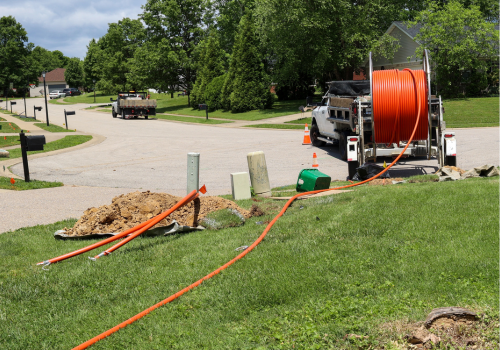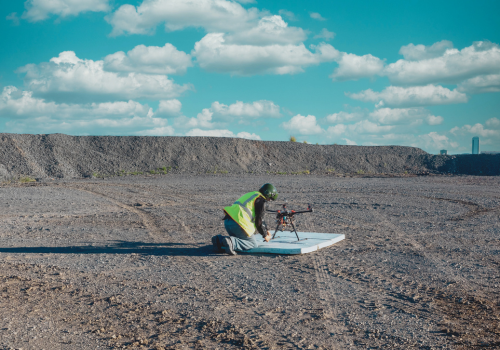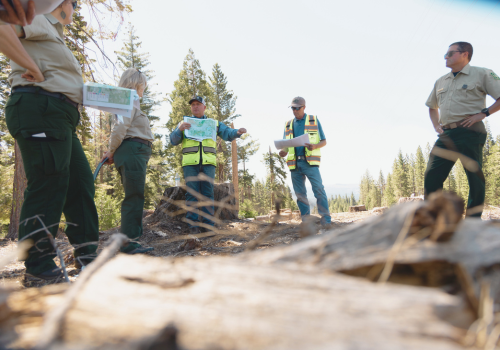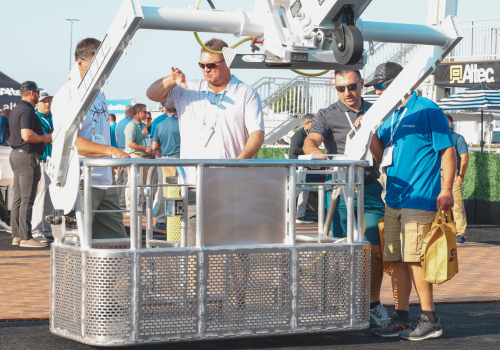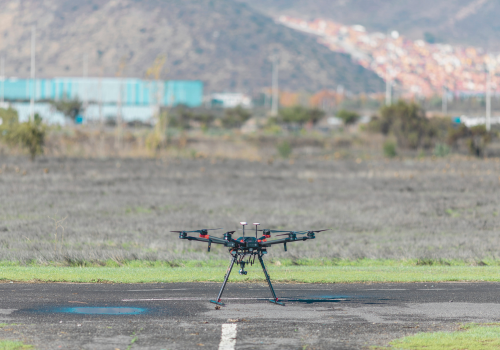A strong arctic front moved across Western Washington and Oregon on Jan. 12 and Jan. 13, 2024, dropping temperatures below freezing. Freezing rain then impacted areas along the coast and the Willamette Valley northward into southwest Washington. Numerous locations including Springfield and the Portland metro area were affected by the icing and strong winds, which caused significant tree damage. According to the NOAA National Centers for Environmental Information, the storm caused an estimated $1.8 billion in damages and the deaths of 20 people. It’s just one of 15 billion-dollar U.S. natural disaster events that have already occurred in 2024. We asked local utilities affected to share how their teams played a vital restoring the community after this event.
How PGE responded
According to Portland General Electric (PGE) Spokesperson John Farmer, the storm that lasted nine days presented a variety of logistical and safety challenges for its teams and crews. “Persistent high winds, snow, ice, frigid temperatures, and the prevalence of downed trees throughout our service area directly impacted our ability to make accurate estimates on restoration times and, in some cases, simply reach problem areas to make damage and repair assessments,” he says.
At the peak of PGE’s restoration efforts, approximately 1,800 personnel, including crews and support staff, and mutual assistance crews from across the state, Washington, Idaho, and California worked to clear debris, assess and repair downed lines, damaged poles, substations and transmission equipment to restore power. Over nine days the crews restored 524,600 customers with the initial Jan. 13 storm peak at 165,000 customers. PGE serves more than 925,000 customers with a service area population of 2 million Oregonians. In total, PGE repaired 23 transmission lines, 69 distribution lines, 14 substations, nearly 600 transformers, and 348 power poles that were damaged in the storm.
Several strategies help PGE prepare for storms and minimize outages including upgrading its equipment to improve resilience. They also conduct routine tree trimming and vegetation management to keep trees, branches, and brush clear on more than 12,000 miles of power lines. Monitoring weather conditions ensures crews and resources are ready to respond. “We continue to deploy and build a network of weather monitoring stations that provide real-time data delivering deeper understanding and forecasting how weather could impact our system,” says Farmer.
How the Portland Water Bureau responded
The same storm that brought significant power outages to Portland resulted in a record number of calls (1093) to the City of Portland Water Bureau on January 13 and more than 4,000 calls over the nine days. A crew of 125 maintenance and construction field staff worked 24/7 to keep water flowing to taps around the city and to respond to requests for emergency assistance. Freezing pipes at homes and businesses stopped water during the freeze, and as temperatures thawed, damage from expanding ice in pipes caused leaks, generating a large demand for emergency shut-offs.
According to Ty Kovatch, Director of Maintenance & Construction for the City of Portland Water Bureau, the widespread power outages significantly amplified the incidence of frozen property-side pipes when residents and businesses lost the ability to heat their buildings. “The high volume of calls challenged our dispatch center, which is typically staffed by two to three people,” says Kovatch. “In the wake of this event, we have added capacity in our dispatch center, and we are adding the option to expand our dispatch capabilities to include call routing to our Customer Service call center. These steps will enhance the efficiency of dispatching calls to our units in the field who are responding to individual homes and businesses in these events.”
The weather event required crews to fix more than 30 water main breaks throughout the city, with just over 20 in 72 hours. According to Kovatch, the city uses break history data to proactively replace approximately 30,000 feet of main each year. “Portland’s water system has an annual break rate of less than seven breaks per 100 miles per year, which is very low for a system of our size,” says Kovatch.
Operating engineers fueled emergency generators daily to keep facilities operating after numerous power outages. Crews in the watershed kept roads plowed and clear of fallen trees to maintain access to critical infrastructure.
Kovatch says the first priority in challenging winter conditions is the safety of its staff. “In anticipation of our team’s response to weather events, we prepare our vehicles to ensure they are properly equipped with traction devices so crews can respond to service calls,” says Kovatch. “Fallen trees have the additional hazard of downed power lines, and for the safety of our crews we either identify alternative routes to areas where response may be needed, or avoid the area until it can be confirmed safe.”
The City of Portland Water Bureau is a member of ORWARN (The Oregon Water/Wastewater Agency Response Network), which helps utilities share personnel, resources, and mutual assistance to facilitate emergency response.
PWB is becoming more resilient to natural disasters with the use of leak detection technologies such as satellite surveys. The survey uses the signature of chlorine detected in drinking water to identify potential leaks. “It’s an efficient method of identifying leaks in the system that may not be presenting themselves above ground, which can be repaired before they become larger issues,” says Kovatch. Advanced metering infrastructure (AMI) will be installed between 2026 and 2030 to provide the utility with real-time information about water use and leaks throughout the system.
How NW Natural responded
While frigid temperatures knocked out power for thousands, NW Natural experienced record demand for natural gas deliveries. Nine million therms of gas deliveries were made to homes and businesses on January 12, about double the average number of therms for a winter day. Due to its underground delivery system, NW Natural was able to retain service to all but about 266 customers.
The area where there was a service disruption occurred in NW Portland when high winds from the storm caused many large fir trees to fall on homes and power lines. One of the fallen power lines in a neighborhood produced an arc fault on a gas main, which had to be shut down for repair. Crews built two temporary bypass lines and used a compressed natural gas trailer to maintain the gas supply to customers until crews were able to access and repair the damaged main line.
In a special report, NW Natural credited careful planning as well as the hard work and dedication of field crews and operations teams for keeping the gas flowing safely for about two million people in the region, many of whom were without power but could still rely on direct use of natural gas in appliances like gas fireplaces, water heaters, stoves, and generators.
Climate change is expected to increase the frequency and intensity of weather events
Of course, winter storms aren’t the only natural disaster to impact utility operations. In July 2024, Hurricane Beryl, a category 1 storm, hit Houston, taking out power for more than two million customers. Perceived slow response to restore power has the electric utility under fire. Hurricanes were responsible for the costliest natural disasters in U.S. history. According to Joe Robledo, Press Officer for US EPA Region 6, hurricanes typically cause loss of power and damage to water infrastructure. “Drinking water facilities may be destroyed leading to entire loss of water as hurricanes may damage piping infrastructure,” says Robledo. Loss of pressure may lead to the introduction of bacterial pathogens which can be mitigated by bringing water to a rolling boil for at least one minute.”
According to Robledo, advanced preparation is the key to a quick recovery. Emergency response plans are required for every water system and include contacts with neighboring water systems, state, and federal staff. Many state public utility commissions require their utilities to file disaster preparedness plans with the commission and crucially approve a variety of emergency preparedness, response, and recovery investments.
Increasingly utilities have put a focus on improving resiliency against hurricanes and other natural disasters by hardening their infrastructure, clearing vegetation around power lines, and advanced weather monitoring. According to Robledo, the EPA has developed programs focused on a resiliency and adaptation methodology for water utilities. For example, the Creating Resilient Water Utilities Initiative provides drinking water, wastewater, and stormwater (water sector) utilities with practical tools, training, and technical assistance to increase system resilience to climate change impacts. EPA’s Water Resilience homepage has many free tools and resources on a variety of topics related to water resilience
With climate change likely to increase the intensity and frequency of natural disasters in the future, utilities must continue to improve resiliency and adjust their response plans to help their communities recover from these devastating weather events.
Subscribe to The Utility Expo monthly newsletter to receive more industry insights like this.
Read Next
How Utility Workers Bring Hope in the Aftermath of Natural Disasters


